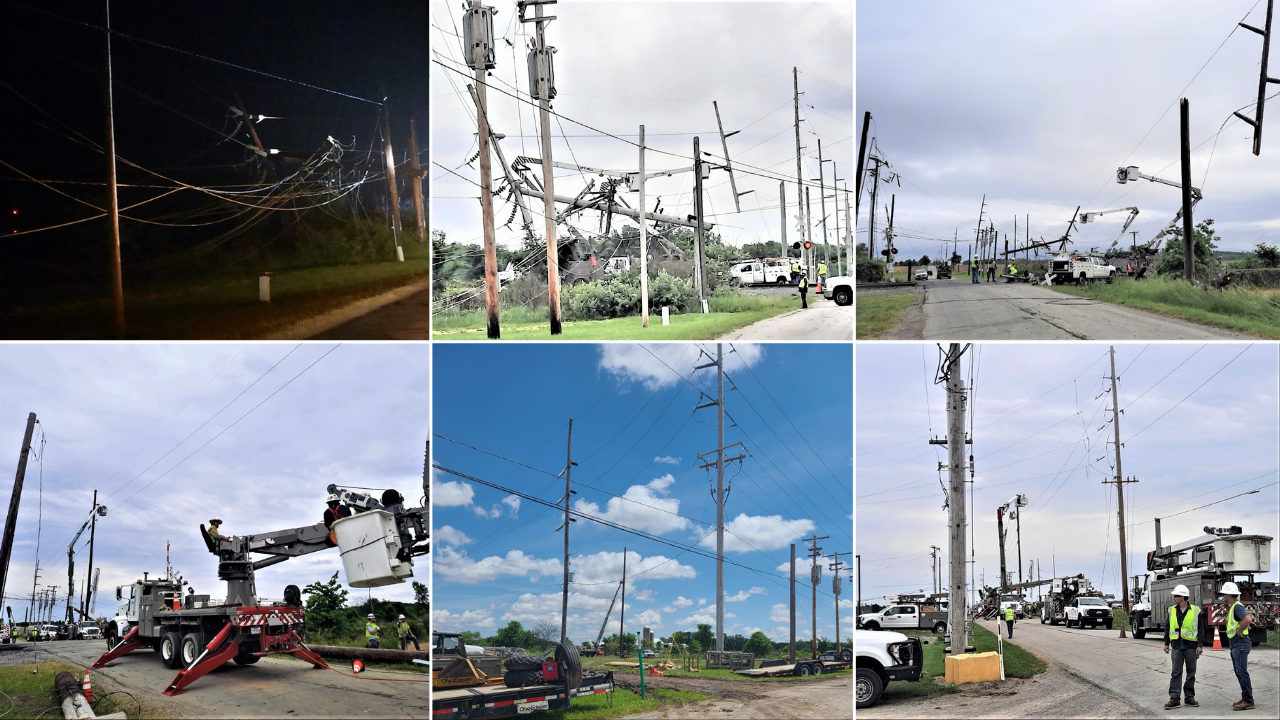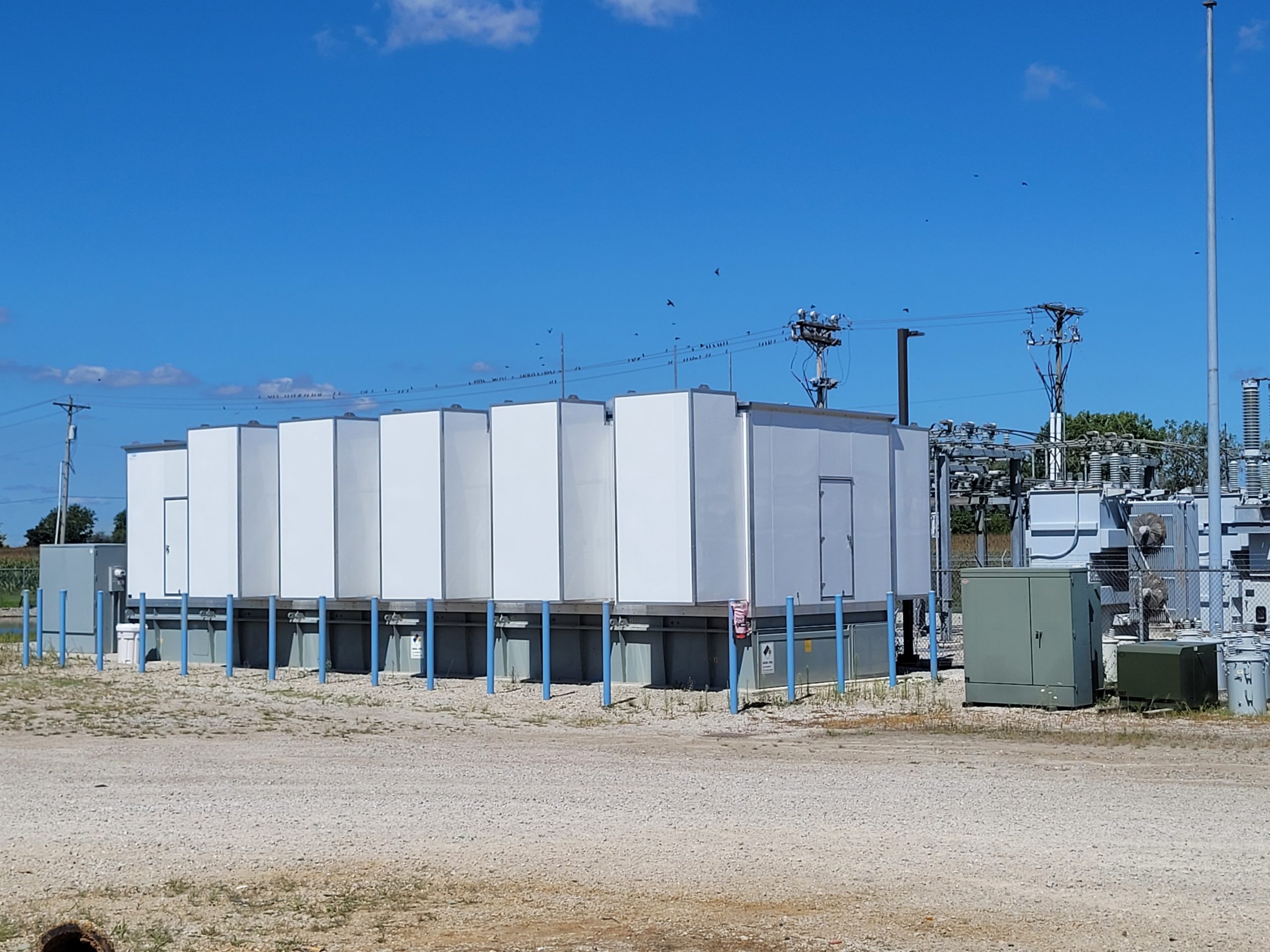Public Power Shines During Outages
6 min reada
a
October 2022
By Zachary Hoffman, manager of communications and publications
When a storm rolls through and the power goes out, electric customers want to know when they will be able to turn their lights back on. Public power utilities rise to the challenge to support their neighbors and communities.

After high-voltage transmission lines fell across railroad tracks in Williams County, Ohio, a train came into contact with them, dragging down 15 poles before it was able to stop. The entire Village of Edgerton was plunged into darkness.
Over the last year, two American Municipal Power, Inc., (AMP) member public power communities have faced major outage events. Though these events were outside of their control, both communities were able to restore and maintain electric service while surrounding service areas were forced to wait in the dark. Many AMP members participate in joint venture projects, allowing their electric system to provide residents and businesses with emergency backup generation — a demonstration of the strength and benefits of the public power model.
Lightning Strikes in the Village of Edgerton
In the late evening hours of June 6, lightning struck a Toledo Edison (FirstEnergy) high-voltage transmission line in Williams County, Ohio, causing it to fall over on a nearby railroad track. Not long after this incident, a train came into contact with the downed powerline, dragging it along and taking down an additional 15 poles in the process before coming to a stop.
As a result, the Village of Edgerton lost its transmission interconnection to FirstEnergy. With the power feed knocked out, the entire village and surrounding areas were blanketed in darkness. As electric crews arrived on scene to assess the situation, it became clear that they were in the midst of a major electric outage event.
The next day, as FirstEnergy began to address necessary repairs, village officials decided to start up the Ohio Municipal Electric Generation Agency (OMEGA) Joint Venture (JV) 2 diesel generators — quickly bringing power back online for village residents.
The generators gave Edgerton residents access to vital electrical service while customers of the investor-owned utility in the surrounding area remained without power. The village stood out like a shining beacon in the darkness, all thanks to their locally controlled electric utility and the strength of joint action.
Across America, one in seven people are served by public power utilities. Public power systems are community owned and not-for-profit, focused on serving the needs of the community along with its residents and businesses, rather than making a profit.
A member of AMP, the Village of Edgerton owns and operates its own public power system. AMP is the nonprofit wholesale power supplier and services provider for 133 members in the states of Indiana, Kentucky, Maryland, Michigan, Ohio, Pennsylvania, Virginia, West Virginia; as well as the Delaware Municipal Electric Corporation, a joint action agency in Smyrna, Delaware. Combined, these member utilities serve approximately 650,000 customers. AMP members receive their power supply from a diversified resource mix that includes wholesale power purchases through AMP and the open market and energy produced at AMP and member-owned generating facilities utilizing fossil fuel, hydroelectric, solar, wind and other renewable resources.
Formed in 1937, the Edgerton Electric Department has provided safe, reliable electric service to village residents for more than 80 years, and Edgerton has been a member of AMP since 1981. Being locally controlled, the utility has the freedom to make decisions that it believes will best serve its residents, rather than being beholden to a larger, regional utility.

Formed in 2000, the OMEGA JV2 project consists of three gas turbine peaking generation units and 34 diesel units with a capacity of 134.096 megawatts (MW). Two of the 1.8-MW diesel generating units from this project are located in Edgerton. The Edgerton Electric Department used these units to supply the community with power for more than 24 hours during the outage.
In 2000, the village chose to join 35 other AMP member communities in forming OMEGA JV2. This project, which was jointly financed by all participating communities and executed by AMP, consists of three gas turbine peaking generation units and 34 diesel units with a capacity of 134.096 megawatts (MW). Two of the 1.8-MW diesel generating units from this project are located in Edgerton.
While the main purpose of the OMEGA JV2 project is to provide participating members with the ability to peak shave during days of high electric usage, it also provides other benefits. In emergency situations, such as the one that occurred in Edgerton in June 2022, the JV2 units can serve as backup generation for the communities that house them.
In total, the Edgerton Electric Department was able to maintain electric service in the village for more than 24 hours using the OMEGA JV2 generating units located within the community. This gave residents the ability to use electricity while FirstEnergy completed the work to restore the community’s power feed.
“Our ability to keep the lights on was in large part thanks to the fact that we are a public power community,” said Dawn Fitzcharles, Edgerton village administrator. “We own our electric system and maintain a great team of employees and partners, giving us the ability to make the decisions that are best for our community. Being able to own and control your own energy resources makes energy more efficient, reliable and safe.”
The situation that occurred in Edgerton was a triumph of public power, but the village is far from the only AMP member community serving as a positive case study for the public power model.
The Village of Woodville Rides Out the Storm
On Dec. 11, 2021, wind gusts of up to 70 miles per hour knocked out the investor-owned transmission lines bringing power to approximately 70,000 people in northwest Ohio, including to the Village of Woodville. While electric customers in the surrounding areas were forced to wait for restoration efforts to be completed, residents and businesses in Woodville experienced only a short outage before their electric service returned.
In 2018, the Village of Woodville Utilities Department decided to participate in AMP’s Behind the Meter Peaking Project. AMP partnered with PowerSecure, one of the nation’s leading distributed energy infrastructure companies, to install a series of generation system installations in a number of AMP member communities, including Woodville.
Consisting of PowerSecure’s diesel generation units, the Behind the Meter Peaking Project was intended to provide participating AMP member communities with additional peak shaving capabilities. However, much like the OMEGA JV2 project, the PowerSecure installations provide the added benefit of emergency backup generation during a major outage event.

The Village of Woodville Utilities Department participates in AMP’s Behind the Meter Peaking Project, which consists of PowerSecure’s diesel generation units. During the December outage, Woodville was able to maintain electric service using the PowerSecure installation. While 70,000 residents in northwest Ohio went without power for eight more hours, the 2,200 residents of Woodville continued to enjoy working electric service.
Rather than wait for power to be restored, the Village of Woodville started the PowerSecure generators located in their community. While 70,000 residents in northwest Ohio went without power for eight more hours, the 2,200 residents of Woodville continued to enjoy working electric service.
“We were very pleased with the performance of the PowerSecure microgrid system and our electric department personnel during the Dec. 11 windstorm,” said Keith Kruse, Woodville village administrator. “Through the AMP program, our village is keeping its wholesale power supply costs in check and avoiding the inconvenience and potential health and other harms of long power outages.”
Public Power Shines Bright
While the Villages of Edgerton and Woodville are two recent examples, there are countless other public power communities across the nation that prove the merits of public power every day. According to the American Public Power Association, outside of major adverse events (such as major storms), customers of public power utilities are likely to go without power for less time — 62 minutes a year compared to 150 minutes a year for customers of private utilities.
“Edgerton faced a situation that would take many communities out of power for days and overcame it,” Fitzcharles said. “That was only possible because of public power, and it is a major reason why I am so thankful to be part of such a wonderful community.”
For public power communities across the country, the sentiment is the same.
To learn more about the benefits of public power, visit www.amppartners.org.


